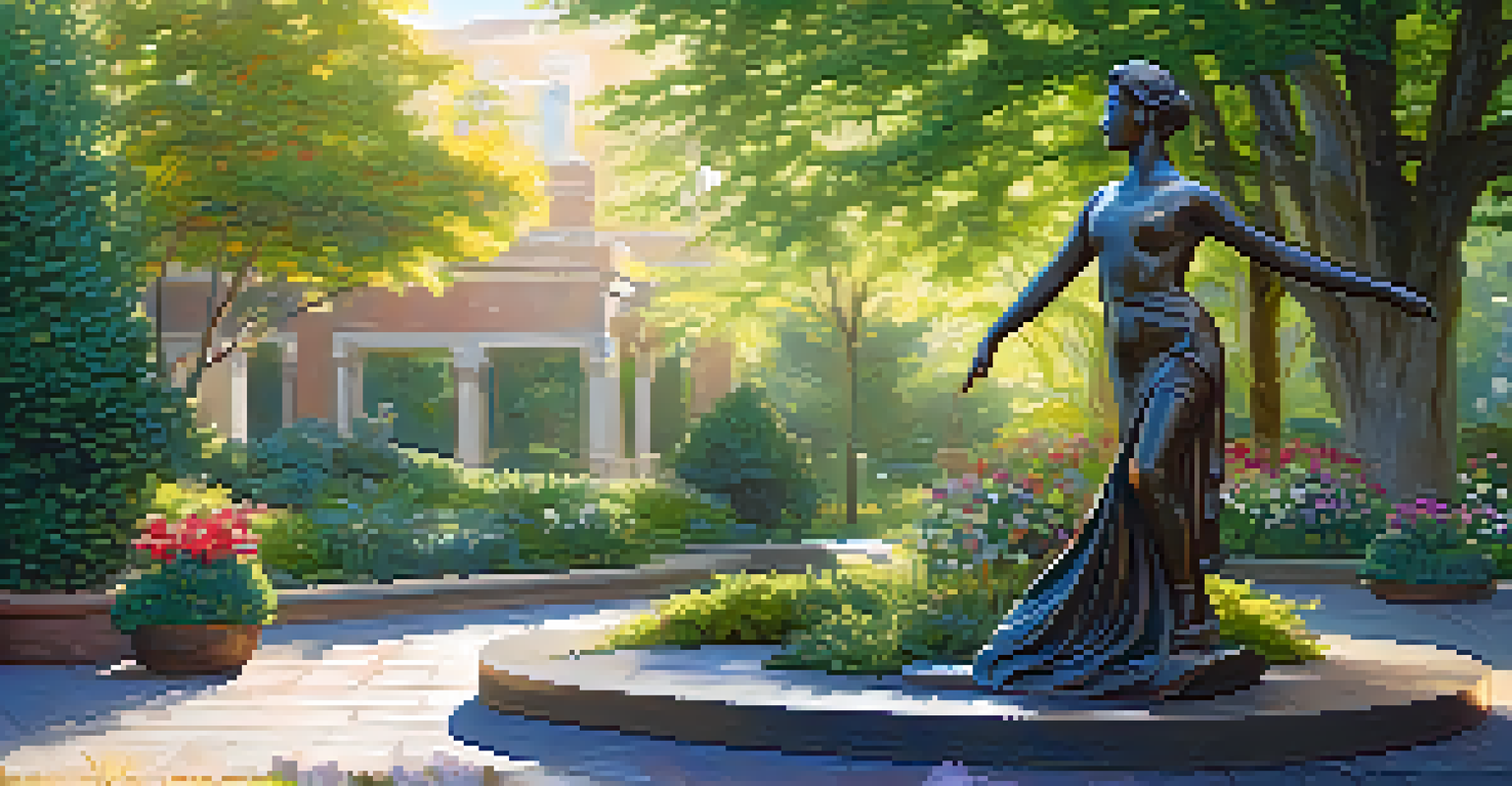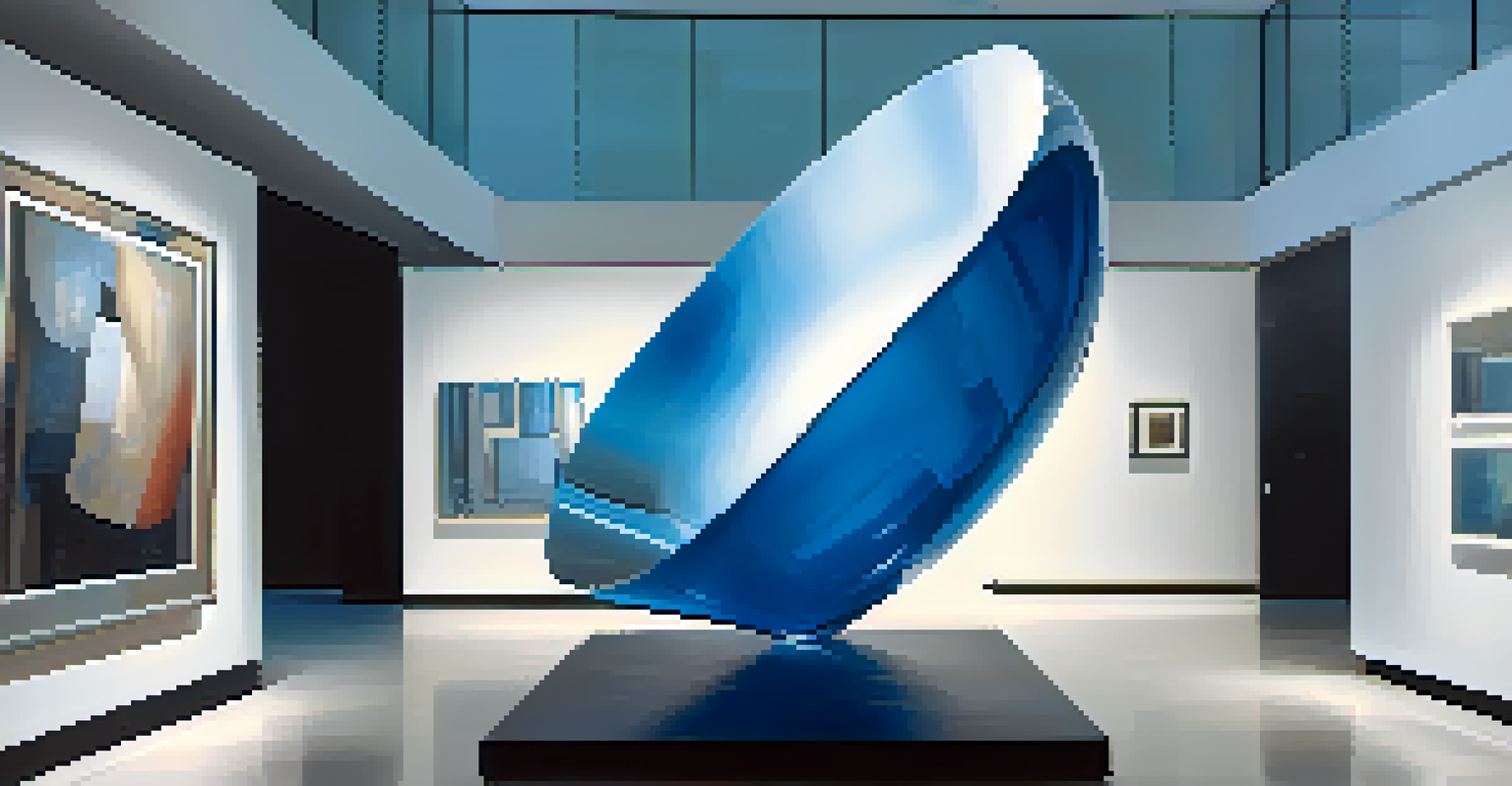How Lighting Affects the Perception of Sculptures

Understanding the Role of Lighting in Art
Lighting is more than just a practical consideration; it profoundly affects how we perceive art. In the world of sculpture, the right lighting can highlight textures, forms, and colors that might otherwise go unnoticed. Imagine walking into a gallery where a statue is bathed in soft, warm light—suddenly, every curve and detail comes alive.
Light is the first element of design; without it, there is no color, form, or texture.
Conversely, harsh or poorly placed lighting can cast unflattering shadows that distort the viewer's experience. It can mask the intricate details or create a flat visual representation of a piece that is rich in depth. This is why artists and curators pay close attention to lighting as a fundamental element of presentation.
Overall, understanding the interplay between light and sculpture can enhance not only the artist's intention but also the viewer's appreciation. By recognizing how light affects perception, we can better understand art and the emotional responses it evokes.
Natural vs. Artificial Lighting: A Comparison
Natural light, with its changing qualities throughout the day, can bring a dynamic aspect to viewing sculptures. For instance, a statue placed in a sunny spot might look different in the morning compared to the afternoon, as the angle of sunlight alters the shadows and highlights. This can create a living experience with the artwork, inviting viewers to return and see it anew.

On the other hand, artificial lighting provides more control over the viewing experience. Curators can manipulate brightness and color temperature to achieve a specific mood or emphasis. For example, a cooler light might highlight certain materials, like marble, making it appear more ethereal.
Lighting Shapes Art Perception
The interplay of light and shadow profoundly influences how viewers perceive and appreciate sculptures.
Ultimately, the choice between natural and artificial lighting depends on the desired effect and context of the sculpture display. Both have unique advantages that, when used thoughtfully, can elevate the perception of the artwork.
The Influence of Color Temperature on Sculptures
Color temperature, measured in Kelvin, affects how we perceive colors in sculptures. Warmer hues (like those around 2700-3000K) enhance the richness of materials such as wood or bronze, giving them a more inviting appearance. This warmth can evoke emotions like comfort and nostalgia, deeply connecting viewers to the artwork.
The light that surrounds us is the light that shapes our perceptions.
In contrast, cooler color temperatures (around 5000K and above) lend a more modern or clinical feel. They can make materials like glass or metal appear sharper and more defined but may also create a sense of detachment. This dichotomy can influence how we interpret the artist's message.
By thoughtfully selecting the color temperature of lights, artists and curators can guide the emotional experience of their audience. This subtle manipulation can change the narrative that a sculpture conveys, prompting viewers to engage on multiple levels.
Shadows: The Unsung Heroes of Sculpture Lighting
Shadows often play a critical role in how sculptures are perceived, adding depth and dimension. They can create a sense of movement, making a static piece feel more alive. For example, the shadows cast by a figure can suggest the posture or emotion of the sculpture, enhancing the narrative.
Additionally, shadows can also highlight textures and intricate details that might otherwise be overlooked. When light hits a sculpture at a specific angle, it can create patterns that draw the eye to certain features, encouraging a closer examination.
Natural vs. Artificial Lighting
Both natural and artificial lighting have unique advantages that can enhance the viewing experience of sculptures.
Understanding the importance of shadows allows artists and curators to create a more immersive experience. By manipulating light to enhance or soften shadows, they can craft a viewing environment that invites contemplation and engagement.
Lighting Techniques: Spotlights, Floodlights, and More
Various lighting techniques can dramatically change the perception of sculptures. Spotlights, for example, focus intense light on specific features, directing attention where it's needed most. This can be particularly effective in showcasing fine details or creating focal points that draw viewers in.
Floodlights, in contrast, provide a broader wash of light that can illuminate an entire space. This technique can create an even, soft effect, making sculptures appear more approachable and inviting. However, too much floodlight can wash out details, so it's all about finding the right balance.
Each technique has its own strengths and can be utilized creatively to enhance the viewer's experience. By combining different lighting methods, curators can craft a dynamic atmosphere that enriches the interaction with the artwork.
The Psychological Effects of Lighting on Audience Experience
Lighting doesn't just affect how sculptures look; it also influences how we feel about them. Bright, vibrant lighting can create a sense of excitement and energy, while softer, dimmer light may evoke contemplation or serenity. This psychological aspect is crucial in how we engage with art.
For instance, a sculpture displayed under dramatic, low lighting might prompt a somber reflection, while the same piece illuminated brightly could inspire joy or curiosity. Understanding these emotional triggers can help artists and curators design experiences that resonate deeply with viewers.
Color Temperature Affects Emotion
The selection of color temperature in lighting can evoke specific emotional responses, guiding audience engagement with the artwork.
By harnessing the psychological effects of lighting, they can craft environments that not only showcase sculptures but also foster emotional connections. This creates a holistic viewing experience that lingers long after the visit.
Case Studies: Successful Lighting in Sculpture Exhibitions
Several exhibitions have masterfully used lighting to enhance the viewing of sculptures. For example, the 'Sculpture at the Sea' exhibition in Australia utilized natural sunlight to create stunning visual effects as the sculptures interacted with the ocean breeze. This not only highlighted the sculptures' textures but also engaged visitors with the environment.
Another notable example is the Guggenheim Museum's display of Alberto Giacometti's sculptures, where strategically placed spotlights created dramatic shadows that emphasized their elongated forms. This approach not only highlighted the artist's unique style but also added a layer of intrigue.

These case studies illustrate how intentional lighting choices can elevate the perception of sculptures, turning a simple exhibition into a transformative experience. By looking at these examples, we can understand the potential of light as a powerful tool in the art world.